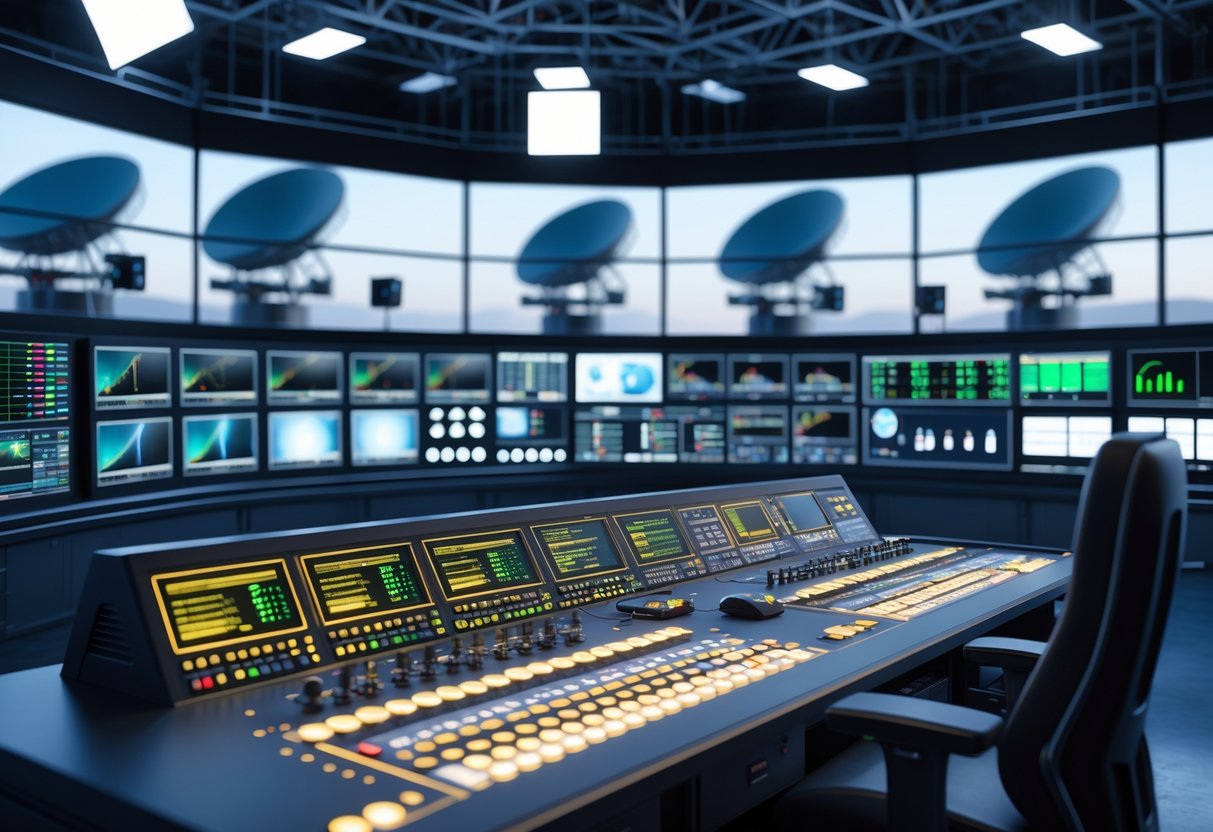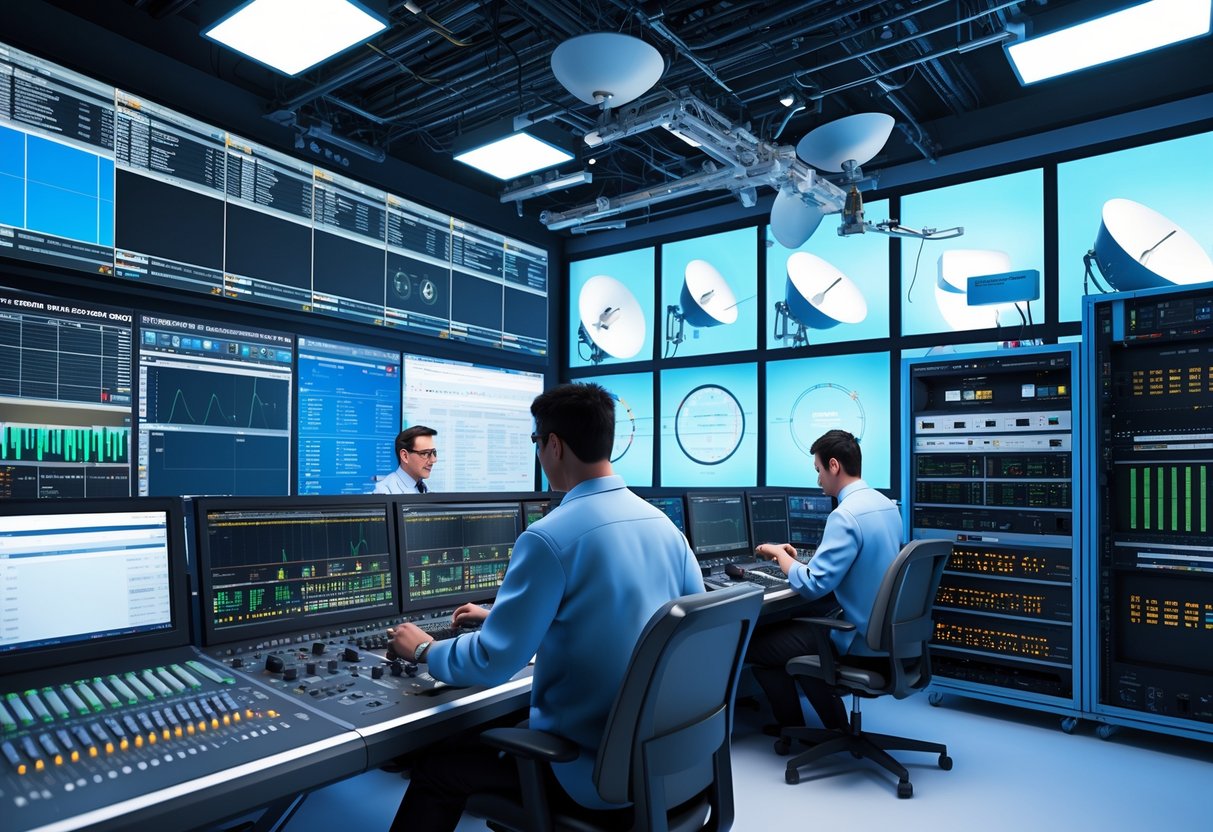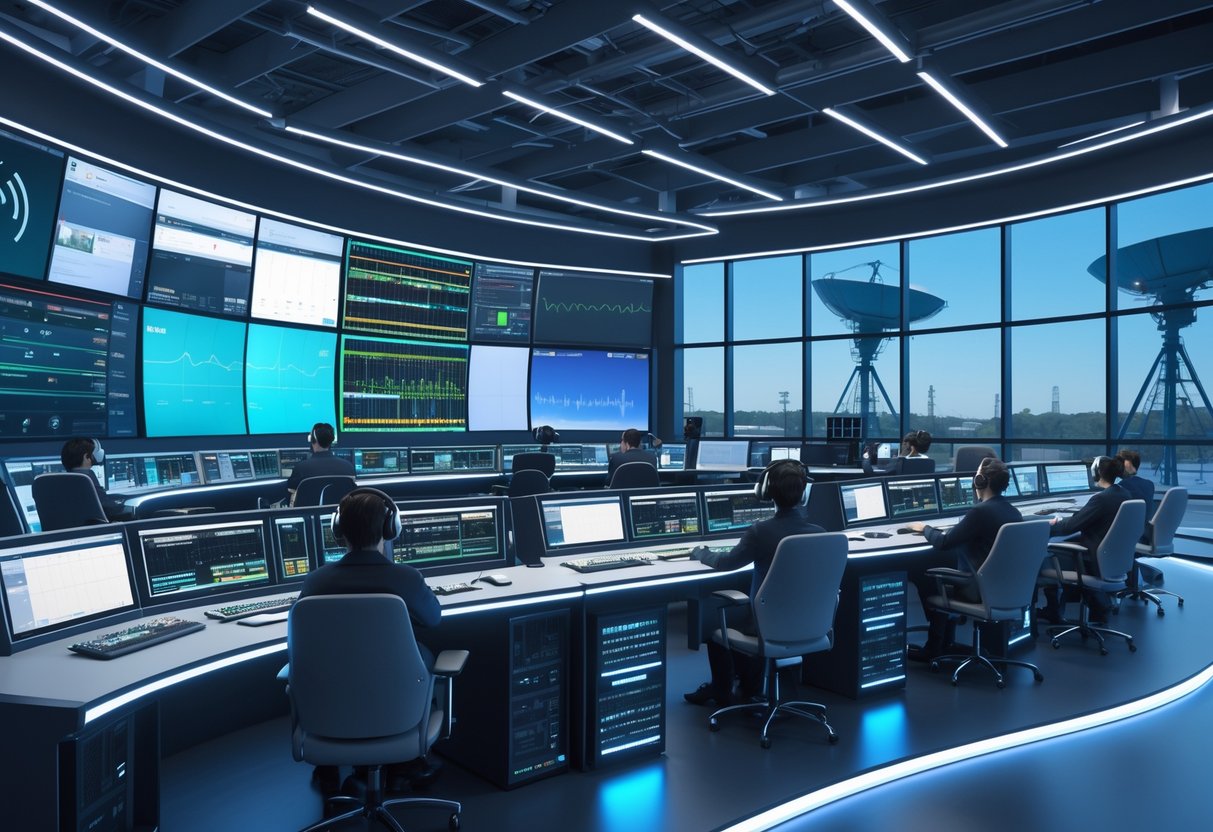Broadcast Technology: Essential Systems, Trends, and Careers
Updated On: November 13, 2025 by Aaron Connolly
Fundamental Principles of Broadcast Technology
Broadcasting runs on some basic ideas that let creators share content with huge audiences all at once—whether that’s through radio waves, cables, or digital networks. It’s all about the one-to-many model and using specific delivery methods to get audio and video out there efficiently.
Definition of Broadcasting
Broadcasting basically means sending out audio, video, or data from one source to lots of receivers, sometimes across entire countries. This tech connects creators and audiences using a bunch of different transmission methods.
You’ll find three main steps in the process. First, signal encoding turns the original content into a format that can travel over the air or cables. Then, transmitters blast those signals out—maybe via radio waves, maybe through satellites. Finally, receivers like TVs and radios decode everything so you can watch or listen.
Unlike point-to-point communication, broadcasting hits tons of people at once. A single radio station might reach thousands at the same time. TV networks can send out shows to millions of homes, all with one signal.
Over time, the tech has moved from old-school analogue to digital. Digital broadcasting gives us better sound and picture and uses up less bandwidth.
Broadcast Models and Delivery Methods
Broadcasters use a few different ways to get their content out, depending on what works best for their audience and budget.
Terrestrial broadcasting relies on transmitters on the ground that send out radio waves. It’s great for local or regional coverage, but you need a lot of towers if you want to go bigger.
Satellite broadcasting uses satellites up in orbit to send signals down to Earth. With just one satellite, you can cover a whole country—or more.
Cable systems bring content straight to homes and businesses through physical cables. You get high-quality signals and sometimes interactive features, but laying all that cable isn’t cheap.
Internet-based delivery streams content over broadband using things like IPTV. This lets people watch what they want, when they want.
| Delivery Method | Coverage Area | Signal Quality | Infrastructure Cost |
|---|---|---|---|
| Terrestrial | Local/Regional | Good | Medium |
| Satellite | National/Global | Excellent | High |
| Cable | Local | Excellent | Very High |
| Internet | Global | Variable | Medium |
One-to-Many Communication
One-to-many communication really sets broadcasting apart from other ways of sharing info. With this setup, one transmitter can reach as many receivers as you want, all at once.
This system works so well because you don’t need a separate connection for every viewer. One TV broadcast can reach millions using the same resources you’d need for just one.
The cost savings are huge. Broadcasting a football match to a million people doesn’t cost much more than sending it to ten, at least when it comes to transmission.
Signal propagation makes all this possible. Electromagnetic waves zip along at light speed, carrying signals across different distances depending on power and weather.
Digital broadcasting takes things further with multiplexing. That’s when broadcasters cram multiple channels into a single stream, so viewers get more options without wasting spectrum.
With one-to-many, live events can go out to the whole world at the same time. People everywhere can tune in together, no matter where they are.
Core Broadcast Systems and Components
The nuts and bolts of broadcast technology come down to a few big pieces: towers that send signals far and wide, antennas that shape and aim those signals, and networks that keep everything connected from one region to the next.
Broadcast Towers and Infrastructure
Broadcast towers keep terrestrial TV and radio running. Some stand just 30 metres tall for local stations, while others soar past 600 metres for the big networks.
Most towers use steel lattice frames. This setup handles strong winds and keeps material costs down. For really tall towers, guy-wires add extra support.
Tower heights by service:
- FM radio: 30-150 metres
- AM radio: 50-300 metres
- Television: 200-600+ metres
- Emergency services: 40-100 metres
Modern towers often carry lots of antenna systems. One tower might handle TV, FM radio, and even mobile phone signals at the same time.
Power backup is a must. Broadcasters set up generators and uninterruptible power supplies, because downtime means lost money. Weather sensors warn engineers about things like ice or high winds.
Choosing where to put a tower isn’t random. Engineers look at coverage, interference, and even flight paths. Towers near airports have to stay under certain heights. Computer models help predict coverage before anyone breaks ground.
Antenna Types and Function
Antennas turn electrical signals into radio waves (and back again). Different designs suit different needs.
Dipole antennas are the go-to for FM radio. They’re simple—just two metal rods that send signals out in all directions.
Yagi antennas focus the signal in one direction. TV antennas on your roof often use this design to pull in weak signals and block out interference.
Parabolic dish antennas are for satellites. Their curved shape beams signals far or collects faint ones from space.
TV antennas on towers usually use panel arrays. These combine several elements to shape the coverage. By tweaking power and timing, engineers can push more signal toward cities or other key areas.
Polarisation also matters for signal quality. TV usually uses horizontal polarisation, while mobile prefers vertical. Some systems use both to double up on channels.
Antenna maintenance isn’t glamorous, but it’s important. Crews check connections, measure signal patterns, and swap out parts damaged by weather.
Broadcast Networks
Broadcast networks make sure programming gets where it needs to go, whether that’s across a city or a whole country.
Terrestrial networks link stations with microwave links and fibre optic cables. The main feed brings in network shows, while local stations can drop in news or ads during set breaks.
Satellite distribution beams programming to cable companies and stations all at once. Uplink sites send digital signals to satellites floating 36,000 kilometres overhead.
Network operations centres keep an eye on everything. Engineers watch audio, video, and timing to keep all the feeds in sync.
Emergency alert systems tie into these networks. If something happens, authorised agencies can cut in and broadcast warnings within seconds.
Digital networks use statistical multiplexing to get the most out of their bandwidth. Popular shows get more, while static stuff takes up less space. This way, the system handles more content overall.
Regional tweaks let networks serve local needs. In the UK, for example, networks might show different programmes in Scotland or Wales but share the big stuff like national news.
Radio Broadcasting Technologies
Radio broadcasting uses electromagnetic waves to send out audio over big distances. Today’s stations mix classic AM with new digital systems and public broadcasting networks.
AM Radio and Evolution
AM radio works by changing the strength of the radio wave to match the sound. The stronger or weaker the signal, the closer it is to the original audio.
AM used to rule the airwaves because its signals travel really far, especially at night when they bounce off the atmosphere. People could pick up stations from hundreds of miles away.
Quick AM facts:
- Frequency range: 540-1600 kHz
- Great for long-distance, especially after dark
- Cheap, simple radios
- Lower sound quality than modern systems
Digital rivals have made life tough for AM. Many stations added audio processors and compressors to boost quality.
Lots of stations switched from old turntables and tapes to computer systems. These digital upgrades help AM stay in the game, even as the tech world keeps moving forward.
AM still matters in rural places where other signals can’t reach. It’s also crucial for emergencies and talk radio.
Digital Radio Innovations
Digital radio turns sound into computer code before sending it out. The result? Clearer audio and less interference than old analogue radio.
Why digital rocks:
- CD-quality sound
- Less static and noise
- Several channels on one frequency
- Scrolling text and info
Internet streaming has flipped the radio scene. Now, stations can reach listeners anywhere—no towers or frequencies needed.
Modern systems lean on IP networks and the cloud. This lets stations run remotely and share shows across different sites.
Satellite radio beams signals nationwide from space. Listeners get the same sound, no matter where they are.
Mobile apps are everywhere now. Many stations focus more on their digital streams than their old-school broadcasts.
Computers handle a lot of the daily programming. Voice tracking lets presenters pre-record bits that play between songs, so stations can keep costs down and still sound polished.
Public Radio Systems
Public radio networks bring communities educational and cultural shows. Most use FM for crisp, stereo sound.
FM highlights:
- Frequency: 88-108 MHz
- Top-notch sound
- Stereo
- Needs line-of-sight to work best
Public stations pull in audio from microphones, digital workstations, and satellites. The audio console mixes everything before sending it out.
A lot of public broadcasters mix old and new. They use both over-the-air signals and digital streaming to reach more people.
Community radio often runs on volunteers and donated gear. Even with simple setups, they keep the sound professional.
Emergency alerts can take over public radio in a crisis. These systems break into regular shows with urgent info.
Schools and colleges often run public radio as a training ground. Students get hands-on experience with real broadcast gear and software.
Television Broadcasting Systems

Television broadcasting uses a few different methods to get audio and video to viewers. The tech has shifted from old analogue signals to digital formats with better quality and more features.
Traditional Television Transmission
Traditional TV relied on analogue signals sent from tall towers. Home aerials picked up those radio waves and turned them into pictures and sound.
Analogue Broadcasting Methods:
- AM (Amplitude Modulation): Changed the signal’s strength to carry info
- FM (Frequency Modulation): Tweaked the frequency for better sound
- VHF/UHF bands: Different frequency ranges for different channels
Cameras captured images and turned them into electrical signals. Towers then broadcast those signals far and wide.
Analogue TV had its downsides. Picture quality dropped off over distance, and bad weather caused interference. People got used to fuzzy screens or “snow.”
Most countries pulled the plug on analogue TV between 2009 and 2015. Digital just offered more—sharper pictures and extra features.
Digital Television
Digital TV turns pictures and sound into data, sort of like a computer does. This gives you way better quality and lets broadcasters squeeze in more channels.
Digital TV perks:
- Super clear pictures, no static
- Multiple channels on one frequency
- Interactive menus and guides
- Improved sound
- On-screen programme info
Digital signals work differently than analogue. You either get a perfect picture or nothing at all—no more fuzzy in-between.
The digital switch started in the late 1990s. Countries set “switch-off” dates for analogue, freeing up spectrum for things like mobile phones.
A lot of digital TV now uses the internet too. Smart TVs let you stream shows alongside regular broadcast channels.
Television Broadcasting Standards
Different regions use their own technical standards for digital TV broadcasting. These standards shape how signals get formatted and sent out.
| Standard | Region | Key Features |
|---|---|---|
| DVB-T | Europe, Asia, Africa | Flexible, works well in cities |
| ATSC | North America | High definition focus |
| ISDB-T | Japan, South America | Mobile TV support |
DVB-T (Digital Video Broadcasting – Terrestrial) covers most of Europe and plenty of other countries. It manages different signal strengths and keeps up in crowded cities.
ATSC (Advanced Television Systems Committee) aims for high-definition pictures in the US and Canada. It delivers great quality, but honestly, it needs stronger signals to work well.
ISDB-T (Integrated Services Digital Broadcasting – Terrestrial) came out of Japan. This one’s really good for mobile devices and portable TVs.
Each standard uses its own techniques to protect signals from interference. They also manage multiple channels differently, which changes how many programs fit on a single frequency.
Digital Audio and Video in Broadcasting
Digital broadcasting turns raw audio and video into compressed digital files. This makes it possible to send them efficiently across all sorts of platforms.
Modern systems rely on compression standards like MPEG for video and advanced audio codecs. IP-based protocols let broadcasters stream and distribute content pretty much anywhere.
Digital Audio Technologies
Digital audio for broadcasting counts on compression codecs to make files smaller without losing much quality. AAC (Advanced Audio Coding) has become the go-to for most broadcasters. It offers solid sound even at lower bit rates, which is a huge win over older formats.
Dolby Digital still matters for surround sound in TV and cinema. Broadcasters use it when spatial audio adds something special to the show.
Audio embedding puts sound right into video streams during transmission. That way, audio and video stay in sync. At the receiving end, audio de-embedding pulls the sound out for separate processing or routing.
Sample rates usually run from 48 kHz (broadcast TV) up to 96 kHz (high-end stuff). Higher sample rates capture more detail, but you’ll need more bandwidth and storage.
Most modern broadcast studios use AES/EBU digital audio interfaces for pro-level connections. These keep signals clean over longer cable runs compared to old-school analog.
Signal Transmission Protocols
IP-based transmission has totally changed how broadcasters move digital content. Protocols like RTMP (Real-Time Messaging Protocol) and RTSP (Real-Time Streaming Protocol) make streaming over regular Ethernet networks a breeze.
These systems fit right in with existing IT setups. Broadcasters can send audio and video over the same networks they use for everything else.
DVB standards still run the show for terrestrial and satellite broadcasting:
| Standard | Application | Coverage |
|---|---|---|
| DVB-T | Terrestrial | Local/regional |
| DVB-S | Satellite | Continental |
| DVB-C | Cable | Urban areas |
Multiplexing packs multiple audio and video streams into a single transmission. This trick lets broadcasters squeeze several programs onto one frequency and really stretch their bandwidth.
Latency management gets critical for live broadcasts. Modern protocols help keep delays super short, especially for sports or breaking news.
Satellite and Remote Broadcasting

Satellites let broadcasters send signals over massive distances and reach places where regular methods just can’t. Remote broadcast setups use portable gear and satellite links to bring live content in from pretty much anywhere.
Communications Satellites in Broadcasting
Communications satellites act as relay stations floating in space. They pick up signals from broadcast centers on Earth and bounce them back to dishes covering huge areas.
Most broadcasting satellites sit in geostationary orbit about 35,786 kilometers up. They stay in the same spot over the planet, so coverage stays steady.
The transmission chain works like this:
• Uplink stations send signals from studios up to satellites
• Satellites boost and retransmit those signals
• Receiving dishes grab the signals for local distribution
Broadcasting satellites really shine when it comes to reaching remote or underserved spots. Rural communities without cable depend on satellite TV and radio.
Modern high-throughput satellites offer way more bandwidth. These newer systems deliver faster data and sharper signals than the older models.
Remote Broadcast Solutions
Remote broadcasts let TV crews send live content from just about anywhere back to the studio. Satellite trucks with portable uplink gear are the workhorses for these jobs.
A typical satellite truck carries:
• A satellite dish antenna aimed at communications satellites
• Video encoding gear to prep signals for sending
• Audio mixing consoles for sound control
• Generators for power on the go
High-speed internet and portable kits have really changed the game for remote production. They give broadcasters backup options and cut down on the gear needed.
IP-based distribution is showing up more and more alongside satellites. Using internet protocols gives broadcasters more reliability and flexibility.
Remote broadcasting is a must for live news, sports, and emergencies. The tech lets crews report in real time from places without permanent broadcast setups, so audiences get the news right away.
Engineering Disciplines in Broadcast

Broadcast technology needs a mix of engineering fields working together to get audio and video out to the world. You’ll find broadcast engineering, audio engineering, and RF engineering all playing their parts.
Broadcast Engineering Overview
Broadcast engineering sits within electrical engineering but focuses on TV and radio gear. Engineers design, install, and maintain all the hardware that keeps broadcasting running.
This field blends electrical engineering and computer science. Engineers handle everything from video signals and audio processing to data transmission.
Key areas:
- Signal processing and transmission
- Equipment setup and maintenance
- Computer networking for broadcasting
- Digital media technology
Most broadcast engineers have a bachelor’s in electrical engineering or broadcast tech. Some jobs take computer engineering or related degrees too.
The job calls for know-how in both hardware and software. Engineers have to fix issues fast to keep broadcasts from going dark.
Roles of Broadcast Engineers
Broadcast engineers look after all the technical gear at TV and radio stations. They make sure signals get out to audiences with steady quality.
Main responsibilities:
- Setting up and configuring broadcast equipment
- Watching signal quality during live shows
- Fixing broken gear and systems
- Updating software and firmware
- Planning upgrades
Many engineers end up specializing. Some stick to studio gear, others focus on transmitters or satellite systems.
Most start out in internships or assistant roles. New engineers get their hands dirty before moving up to senior spots.
The job mixes routine maintenance with emergency repairs. When something breaks during a live show, engineers have to jump in and fix it—no pressure, right?
Audio and RF Engineering
Audio engineering covers everything sound-related in broadcasting. These folks make sure audio stays crisp and clear for listeners and viewers.
Audio engineers handle microphones, mixers, and digital audio systems. They balance levels and cut out interference or distortion.
RF engineering deals with radio frequency systems and signal transmission. RF engineers design and maintain the systems that move broadcast signals to the audience.
They work with transmitters, antennas, and amplifiers. Their job is to keep signal strength and coverage where it needs to be.
Both roles need deep technical chops. Audio engineers must know acoustics and sound processing, while RF engineers need expertise in electromagnetic theory and antennas.
These specialists often team up with broadcast engineers when tricky technical problems pop up.
Broadcast Technology Operations and Workflow

Broadcast operations depend on skilled technicians who keep complex systems running. Getting content from studio to audience takes teamwork between technical staff, automated gear, and mobile production teams.
Broadcast Technicians and Responsibilities
Broadcast technicians are the backbone of TV and radio. They keep equipment working, watch over signal quality, and fix issues during live shows.
Their daily work includes running cameras, audio boards, and video switchers. Technicians also handle transmission gear and keep signals routed correctly.
Key tasks:
- Maintaining and calibrating equipment
- Monitoring signals for quality
- Supporting live productions
- Troubleshooting under pressure
Plenty of technicians focus on a specialty—audio, video, or transmission. They work closely with producers and directors to make sure broadcasts go smoothly.
The job takes technical know-how and quick thinking. Technicians often work late nights and weekends, since that’s when most shows air.
Studio and Automated Systems
Modern studios lean heavily on automated workflows. Automated systems handle tasks like file transfers, tagging, and scheduling.
Automated playout systems run program schedules and commercials. They cut down on mistakes and let smaller teams handle big operations.
Studio automation covers:
- Robotic cameras with preset moves
- Audio mixing with auto fades
- Graphics insertion triggered by timecodes
- Recording systems that start and stop on their own
Asset management systems organize massive media libraries. AI-powered indexing lets broadcasters search for clips in seconds from thousands of hours of footage.
Centralized control systems help operators manage several subsystems at once. This setup boosts efficiency and means you don’t need as many specialized staff in every area.
Outside Broadcasting Operations
Outside broadcasts (OB) bring live coverage from the field back to the studio. These setups need portable gear and reliable links.
Mobile production units act as mini studios on wheels. They pack cameras, mixers, transmission gear, and editing tools into trucks or trailers.
Newer OB operations lean on IP-based workflows instead of classic broadcast cables. This change makes signal routing more flexible and cuts down on infrastructure.
Remote production setups include:
- Satellite uplinks for long-distance feeds
- Fibre connections for top-quality video
- Wireless systems for camera crews
- Cloud-based editing for instant processing
REMI (Remote Integration Model) lets the production team stay at base while tech crews work on location. This approach saves travel costs and lets experts cover several events at once.
IP tech lets broadcasters send signals anywhere, with barely any delay. That’s a game-changer for remote productions.
IT and Storage Solutions in Broadcasting

Modern broadcasting runs on advanced IT systems and storage setups. These systems juggle everything from live feeds to archived shows, all while supporting global teamwork and instant access.
Integration of Information Technology
Information technology is now the backbone of broadcast operations. Broadcasters are moving away from big, single-purpose systems. Instead, they pick smaller, connected systems that work together.
This modular approach saves money and makes upgrades easier. You can choose each system for what it does best, instead of settling for a jack-of-all-trades.
The move to cloud-first workflows has really changed the game. Remote teams can access the same files and systems as in-house staff. This flexibility proved crucial when teams suddenly had to work from different places.
AI-driven automation is now standard in broadcast IT. These tools tag content, back up files, and organize everything automatically. That means technical staff can spend more time on creative work.
Modern broadcast IT needs to support lots of ways to deliver content. Teams want systems that handle traditional broadcasts, social media clips, and streaming platforms all at once.
Role of Computer Engineering
Computer engineering shapes how we build broadcast storage and workflow systems. Engineers juggle performance, reliability, and cost when they create these complicated setups.
Real-time processing sets broadcast engineering apart. Unlike regular IT systems that can buffer or delay, broadcast systems have to run live content with zero interruptions. So, engineers set up systems with backup paths and instant failover to keep things running.
Storage systems need to keep up with massive data rates. Just one 4K camera spits out several gigabytes every minute. Engineers design storage arrays that can write all this data while editors pull up other files for current projects.
Network architecture really matters in broadcast workflows. Engineers put together networks that move huge video files quickly from one system to another. They often choose specialised high-speed connections instead of standard office networks.
Mixing traditional broadcast gear with modern IT takes careful planning. Legacy systems might use different protocols or data formats than the latest cloud-based tools.
NAS and SAN Storage Devices
Network Attached Storage (NAS) and Storage Area Networks (SAN) form the backbone of broadcast data management. Each one brings its own strengths depending on what the workflow needs.
NAS systems plug straight into the network and show up as shared drives for everyone. They’re usually easier to set up and manage than SANs. Smaller broadcast teams often go for NAS since it doesn’t need as much specialised know-how.
SAN storage runs on a dedicated high-speed network just for storage traffic. This setup means storage doesn’t have to fight with other network tasks. Big broadcast centres lean toward SAN since it handles more users and higher data rates at once.
These days, many storage systems blend both approaches. A hybrid architecture might use SAN for fast access to active projects, then move finished work to NAS for long-term storage.
Tiered storage strategies automatically shuffle files between storage types based on how often they’re used. Hot files stay on fast SSDs, while older, archived stuff moves to slower but cheaper drives. This way, engineers balance speed with budget.
Cloud integration adds another twist to broadcast storage. Many teams keep current work on local storage and back up finished projects to the cloud for disaster recovery and remote access.
Industry Bodies, Education, and Professional Growth

Professional organisations and educational programs shape careers in broadcast technology. The Society of Broadcast Engineers leads industry certification, and training programs help people keep up with fast-changing tech.
Society of Broadcast Engineers
The Society of Broadcast Engineers (SBE) stands as the main professional body for broadcast technicians and engineers around the world. Since 1964, SBE has supported over 5,000 members working in radio, television, and digital media.
Membership benefits include technical resources, networking, and continuing education programs. Members get monthly publications covering trends and new tech.
SBE runs local chapters in major markets. These chapters hold monthly meetings with equipment demos and technical talks.
Professional networking happens at regional conferences and the annual National Meeting. Engineers connect with manufacturers and industry leaders at these events.
The organisation sets technical standards and best practice guidelines. These help stations follow regulations and keep up broadcast quality.
Certification and Training
SBE offers certification programs to prove technical skill in different broadcast areas. There are eight levels, from Certified Broadcast Technologist up to Professional Broadcast Engineer.
To get certified, candidates pass written exams on electronics, broadcast systems, and regulations. Higher levels require field experience and ongoing education credits.
Training opportunities come from manufacturer workshops, online courses, and hands-on seminars. Vendors often run special training on new tech like IP-based systems and cloud broadcasting.
Many broadcasters ask for SBE certification when hiring. Certified engineers usually earn more and move up faster.
Continuing education keeps engineers up to date. SBE requires recertification every five years, making sure members stay current.
Technical colleges and universities now offer degrees in broadcast technology. Courses cover traditional RF systems and modern IT networking and streaming.
Trends and Future Directions in Broadcast Technology

Broadcasting is changing fast with artificial intelligence and internet protocol-based workflows. These shifts are changing how we create, deliver, and consume content—both on traditional TV and new digital platforms.
Next-Generation Broadcast Standards
SMPTE 2110 now anchors modern broadcasting. This standard lets broadcasters move away from old hardware and toward flexible, software-driven workflows.
IP-based production is shaking up live sports coverage. Remote production hubs now handle big events without hauling truckloads of gear to venues. This saves money and cuts carbon emissions.
5G networks are speeding up remote broadcasting. The low latency means teams can work together across continents in real time. Mobile broadcasting is seeing big gains from this.
Hybrid cloud adoption is the new normal. Broadcasters keep critical work on-site and use public cloud for overflow. This setup saves money but still gives them control where it matters.
Virtual outside broadcasting now uses off-the-shelf servers instead of traditional trucks. Even smaller sports leagues can get pro-quality live production without huge upfront costs.
Emerging Technologies in the Field
Artificial intelligence is taking over routine content workflows. AI tools spit out sports highlights just minutes after the action. Machine learning has made metadata tagging and content discovery way smarter.
Personalisation engines are changing how viewers watch. Analytics track what we like and where we are, so broadcasters can recommend content that fits. Dynamic ad insertion with SCTE standards brings in new ways to make money.
Mobile-first strategies are flipping old content models. Vertical videos for TikTok and similar platforms are now influencing TV broadcasters. Live polls and chat features are popping up as standard viewer engagement tools.
Cybersecurity has become a top concern as broadcasting moves to software and the cloud. New rules push vendors to build secure-by-design products. It’s still tough to lock down legacy hardware, though.
Sustainability metrics are now business must-haves, not just PR fluff. Companies look for energy-efficient solutions and ways to reuse equipment, and these factors drive buying decisions across the industry.
Frequently Asked Questions

Here you’ll find answers about education requirements, career paths, and how broadcast tech touches daily life and society. We’ll dig into technical qualifications, broadcasting methods, real-world uses, and the cultural influence of modern media.
What qualifications do you need to pursue a course in broadcast technology?
Most broadcast tech courses ask for GCSEs in maths, English, and science. Having ICT or media studies helps, too.
For degrees, you’ll need A-levels or similar. Physics, maths, media studies, or computing are popular subjects.
Technical colleges offer hands-on routes, like BTECs in media production or electrical engineering. Some focus on broadcast equipment and maintenance.
Experience counts as much as formal qualifications. Colleges often look for work placements at radio or TV stations. Volunteering with community broadcasters can boost your application.
How has television technology evolved over the years?
Television started with black-and-white analogue broadcasts. Early TVs were big, heavy, and had tiny screens with iffy picture quality.
Colour TV came along in the ’60s and ’70s. This meant new broadcast gear and new TVs for homes across the UK.
Digital broadcasting replaced analogue in 2012, making pictures sharper and allowing more channels on the same airwaves.
High-definition (HD) and ultra-HD (4K) are now standard. Broadcasts include surround sound and interactive features.
Streaming services changed the game again. Now we watch on phones, tablets, and smart TVs. Live shows compete with on-demand content from the internet.
Could you explain the different types of broadcasting methods used in mass communication?
Terrestrial broadcasting uses radio towers to send signals over the air. This covers channels like BBC One and ITV, and radio stations use it too.
Satellite broadcasting beams signals from space satellites to dish receivers. Sky TV and Freesat use this. It can reach places where terrestrial signals struggle.
Cable broadcasting sends signals through cables right into homes. Virgin Media leads on this in the UK. It allows interactive services and fast internet.
Digital broadcasting turns audio and video into computer data. This makes signals more reliable and packs more channels onto one frequency. All UK broadcasts are digital now.
Internet broadcasting streams content over broadband. Netflix, YouTube, and BBC iPlayer work this way. You can watch on any device that’s connected.
What examples can illustrate the use of broadcast media in everyday life?
Morning radio shows get millions started with news and music. Local stations give commuters traffic updates.
Television news keeps us up to date on current events. Weather forecasts help us plan what to wear or do.
Emergency broadcasts warn us about bad weather or safety threats. The Emergency Alert System can break into normal programming during crises.
Sports broadcasts bring big events home. The World Cup, Olympics, and Premier League reach huge audiences worldwide.
Educational programmes teach kids and adults new skills. The BBC’s educational content supports schools and lifelong learning.
Entertainment shows help us relax after a long day. Comedy, drama, and reality TV connect people with popular culture.
What are the career prospects for graduates with a degree in broadcast technology?
Broadcast engineers keep transmission equipment running. They work at TV and radio stations or for broadcast companies. Starting salaries are usually £18,000 to £25,000.
Studio technicians handle cameras, sound, and lighting during shows. They might work on live, recorded, or outside broadcasts.
Transmission technicians make sure signals reach viewers and listeners. They monitor quality and fix problems fast.
Post-production specialists edit video and audio. They add graphics, effects, and mix sound for finished programmes.
Network engineers design and maintain the backbone of broadcasting. They plan new sites and upgrade old equipment.
Freelance gigs are common, too. Wedding videographers, corporate video producers, and live event techs often work on their own.
What role does broadcast technology play in shaping public opinion and culture?
Television and radio reach huge audiences all at once. They create these big shared moments, especially during things like royal weddings or national celebrations.
News programmes help people make sense of current events. Editors decide which stories to show, and those choices end up shaping what people care about.
Advertising during broadcasts pushes consumer habits in new directions. Companies pour billions into grabbing viewers’ attention during hit shows and prime listening hours.
Cultural programmes open the door to fresh ideas and viewpoints. When you catch a documentary, an arts show, or something international, it just broadens your view of the world a bit.
Local broadcasting really brings communities together. Regional news, local sports, and community programming help folks hold onto their local identity.
Social media takes broadcast content even further. Viewers jump online to talk about what they’ve just watched, starting new conversations and keeping topics alive.

